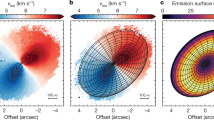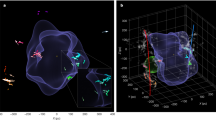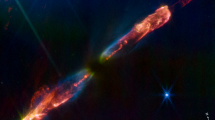Abstract
The exact processes by which interstellar matter condenses to form young stars are of great interest, in part because they bear on the formation of planets like our own from the material that fails to become part of the star. Theoretical models suggest that ejection of gas during early phases of stellar evolution is a key mechanism for removing excess angular momentum, thereby allowing material to drift inwards towards the star through an accretion disk1,2. Such ejections also limit the mass that can be accumulated by the stellar core1,2. To date, these ejections have been observed to be bipolar and highly collimated, in agreement with theory. Here we report observations at very high angular resolution of the proper motions of an arc of water-vapour masers near a very young, massive star in Cepheus. We find that the arc of masers can be fitted to a circle with an accuracy of one part in a thousand, and that the structure is expanding. Only a sphere will always produce a circle in projection, so our observations strongly suggest that the perfectly spherical ejection of material from this star took place about 33 years earlier. The spherical symmetry of the ejecta and its episodic nature are very surprising in the light of present theories.
This is a preview of subscription content, access via your institution
Access options
Subscribe to this journal
Receive 51 print issues and online access
$199.00 per year
only $3.90 per issue
Buy this article
- Purchase on Springer Link
- Instant access to full article PDF
Prices may be subject to local taxes which are calculated during checkout


Similar content being viewed by others
References
Shu, F. H., Adams, F. C. & Lizano, S. Star formation in molecular clouds—Observations and theory. Annu. Rev. Astron. Astrophys. 25, 23–81 (1987).
Lizano, S. & Torrelles, J. M. (eds) Circumstellar disks, outflows, and star formation. Rev. Mex. Astron. Astrofis. Ser. Conf. 1, (1995).
Cheung, A. C., Rank, D. M., Townes, C. H., Thornton, D. D. & Welch, W. J. Detection of water in interstellar regions by its microwave radiation. Nature 221, 626–628 (1969).
Reid, M. J. & Moran, J. M. Masers. Annu. Rev. Astron. Astrophys. 19, 231–276 (1981).
Genzel, R., Reid, M. J., Moran, J. M. & Downes, D. Proper motions and distances of H2O maser sources. I—The outflow in Orion-KL. Astrophys. J. 244, 884–902 (1981).
Miyoshi, M. et al. Evidence for a black hole from high-rotation velocities in a sub-parsec region of NGC4258. Nature 373, 127–129 (1995).
Rodríguez, L. F., Ho, P. T. P. & Moran, J. M. Anisotropic mass outflow in Cepheus A. Astrophys. J. 240, L149–L152 (1980).
Ho, P. T. P., Moran, J. M. & Rodríguez, L. F. Mass outflow in star formation regions—Cepheus A. Astrophys. J. 262, 619–635 (1982).
Torrelles, J. M., Rodríguez, L. F., Cantó, J. & Ho, P. T. P. A circumstellar molecular gas structure associated with the massive young star Cepheus A-HW 2. Astrophys. J. 404, L75–L78 (1993).
Rodríguez, L. F. et al. Cepheus A HW2: A powerful thermal radio jet. Astrophys. J. 430, L65–L68 (1994).
Torrelles, J. M. et al. The thermal radio jet of Cepheus A HW2 and the water maser distribution at 0.08″ scale (60 AU). Astrophys. J. 457, L107–L111 (1996).
Torrelles, J. M. et al. Systems with H2O maser and 1.3 centimeter continuum emission in Cepheus A. Astrophys. J. 509, 262–269 (1998).
Hughes, V. A. & Wouterloot, J. G. A. The star-forming region in Cepheus A. Astrophys. J. 276, 204–210 (1984).
Elitzur, M., Hollenbach, D. J., McKee, C. F. Planar H2O masers in star-forming regions. Astrophys. J. 394, 221–227 (1992).
Kaufmann, M. J. & Neufeld, D. A. Water maser emission from magnetohydrodynamic shock waves. Astrophys. J. 456, 250–263 (1996).
Marvel, K. B. The circumstellar environment of evolved stars as revealed by studies of circumstellar water masers. Publ. Astron. Soc. Pacif. 109, 1286–1287 (1997).
Gwinn, C. R. Hypersonic acceleration and turbulence of H2O masers in W49N. Astrophys. J. 429, 241–252 (1994).
Leppanen, K., Liljestrom, T. & Diamond, P. Submilliarcsecond linear polarization observations of water masers in W51M. Astrophys. J. 507, 909–918 (1998).
Claussen, M. J., Marvel, K. B., Wootten, A. & Wilking, B. A. Distribution and motion of the water masers near IRAS 05413-0104. Astrophys. J. 507, L79–L82 (1998).
Furuya, R. S. et al. A microjet: a protostar's cry at birth. Astrophys. J. 542, L135–L138 (2000).
Patel, N. A. et al. Proper motion of water masers associated with IRAS 21391+5802: Bipolar outflow and an AU-scale dusty circumstellar shell. Astrophys. J. 538, 268–274 (2000).
Acknowledgements
NRAO is operated by Associated Universities, Inc., under cooperative agreement with the National Science Foundation. This work was partially supported by MCYT and Programa de Cooperación con Iberoamérica (Spain), and DGAPA and CONACyT (México).
Author information
Authors and Affiliations
Corresponding author
Rights and permissions
About this article
Cite this article
Torrelles, J., Patel, N., Gómez, J. et al. Spherical episodic ejection of material from a young star. Nature 411, 277–280 (2001). https://doi.org/10.1038/35077020
Received:
Accepted:
Published:
Issue Date:
DOI: https://doi.org/10.1038/35077020
This article is cited by
-
Radio jets from young stellar objects
The Astronomy and Astrophysics Review (2018)
-
Vlbi Water Maser Proper Motion Measurements in Star-Forming Regions
Astrophysics and Space Science (2005)
-
A collimated jet of molecular gas from a star on the asymptotic giant branch
Nature (2002)
-
Young star blows baffling bubble
Nature (2001)
-
A stellar performance
Nature (2001)
Comments
By submitting a comment you agree to abide by our Terms and Community Guidelines. If you find something abusive or that does not comply with our terms or guidelines please flag it as inappropriate.



